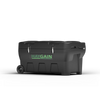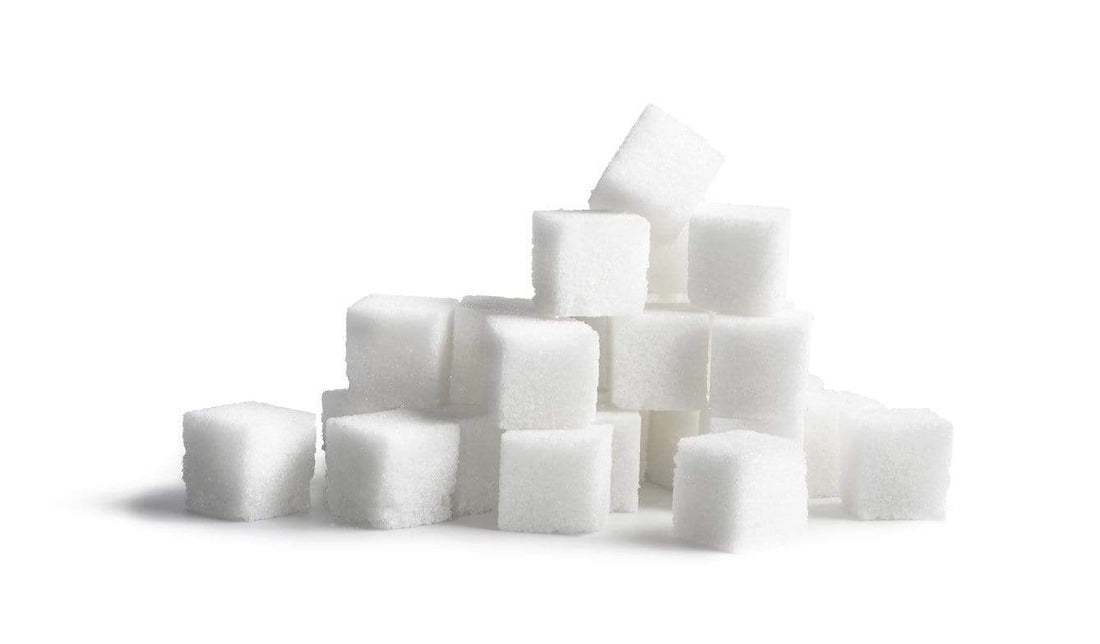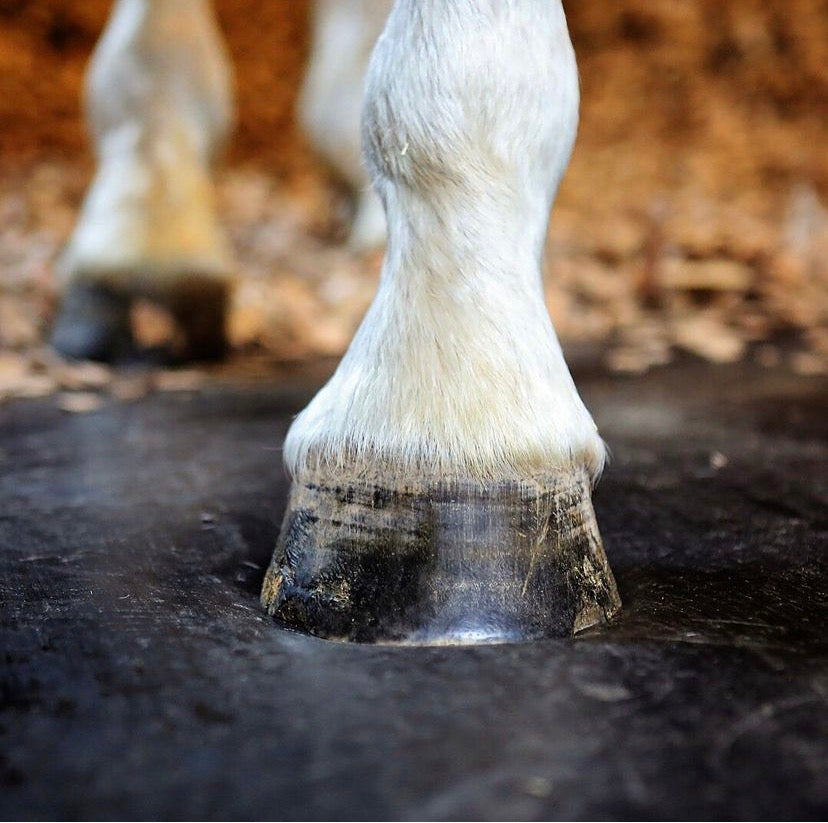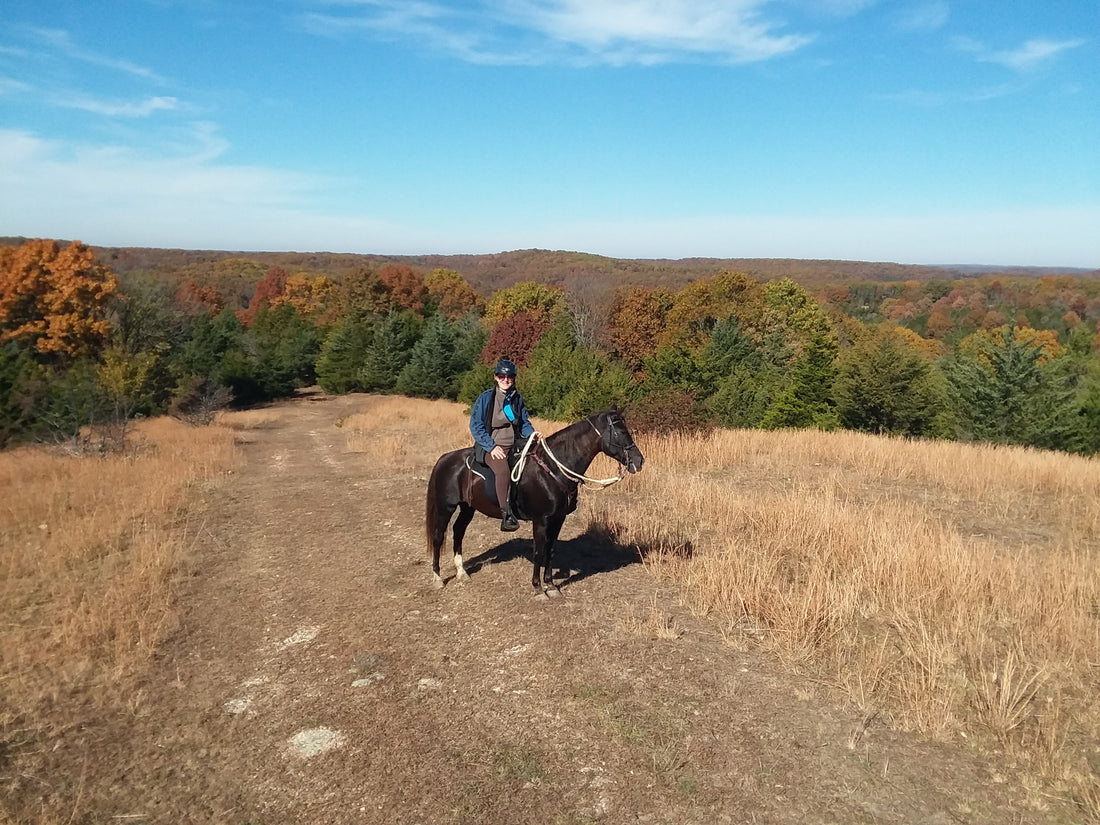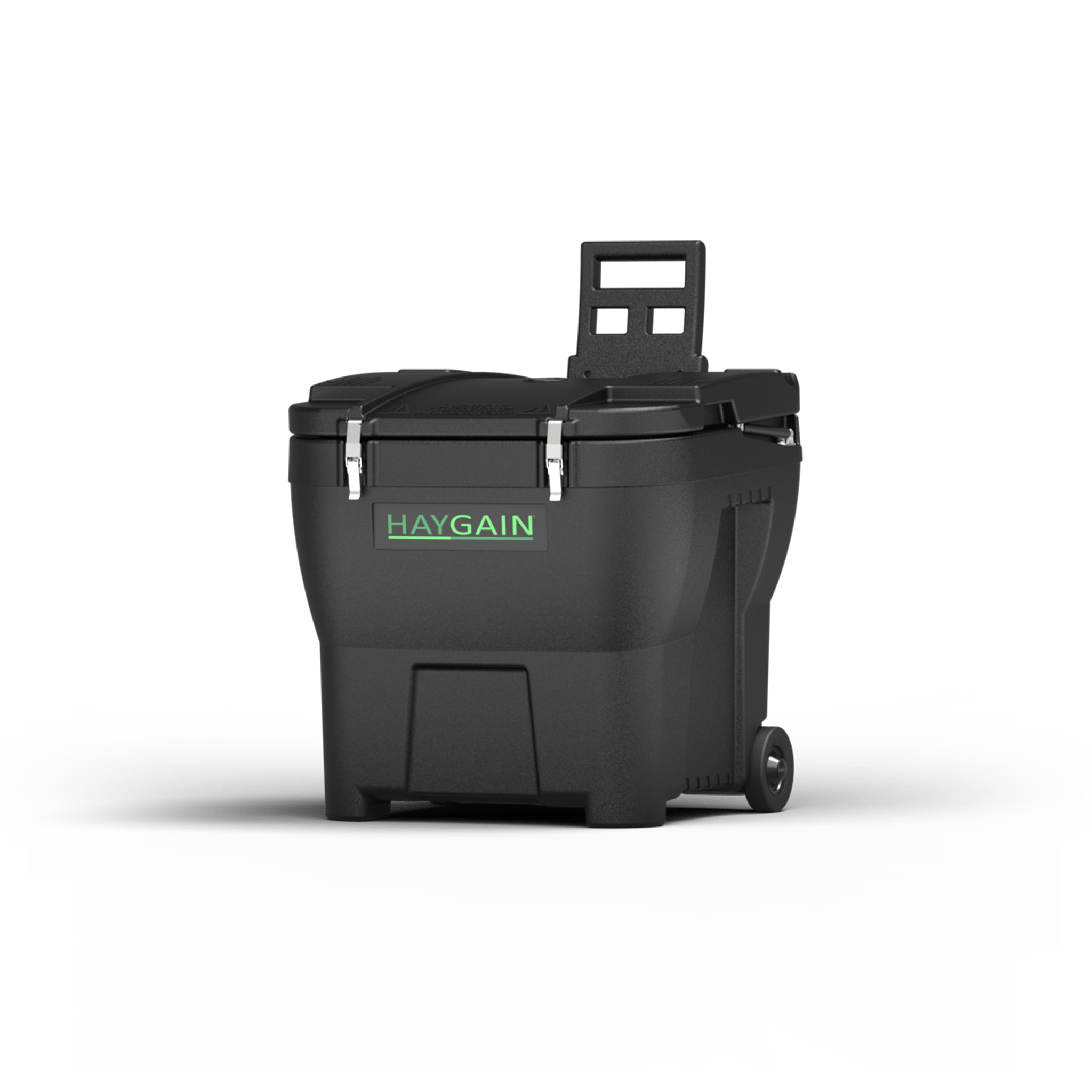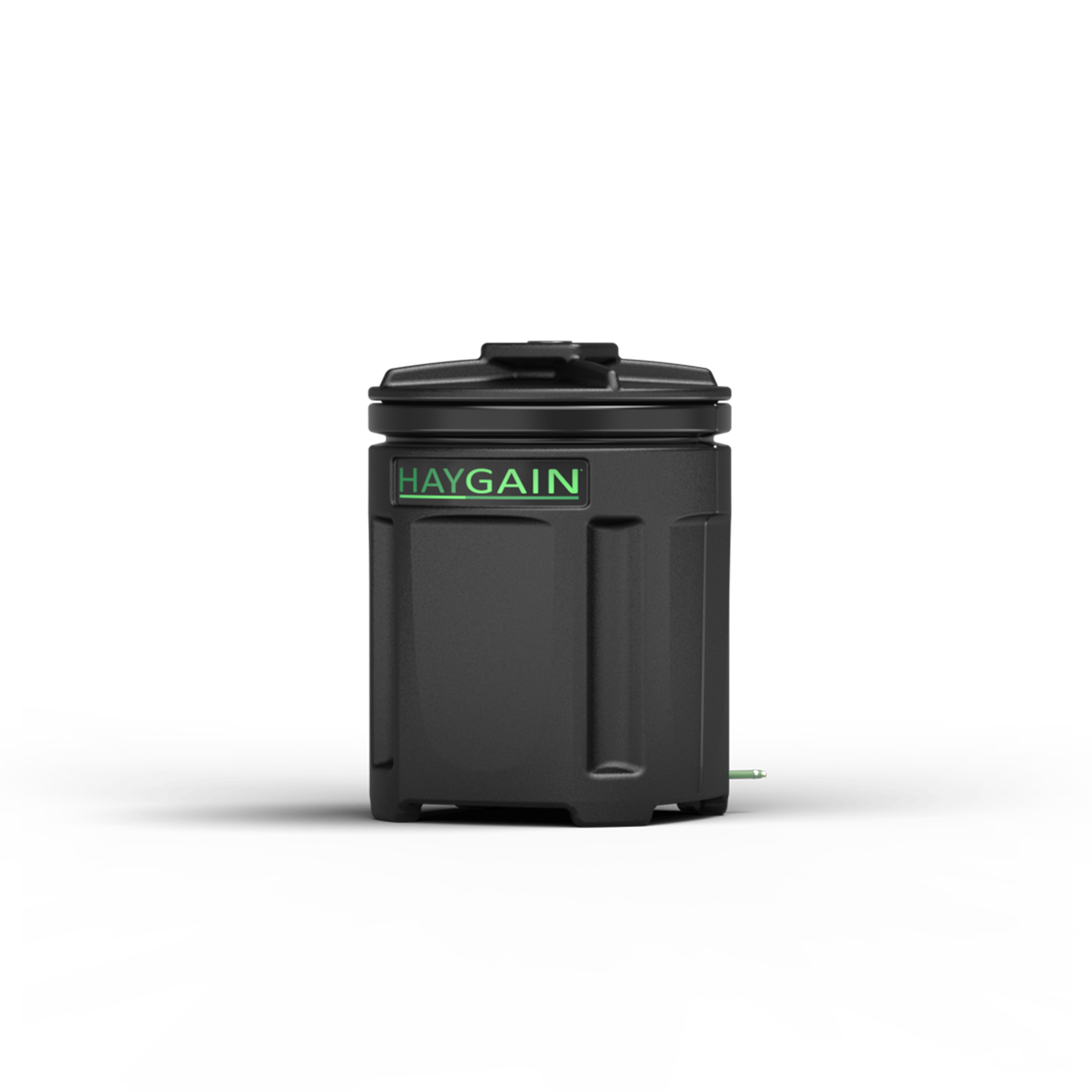Written by Professor Meriel Moore Colyer
Introduction
Soaking or high-temperature steaming hay before feeding is common practice among many categories of horse owners, but the reasons behind these pre-feeding treatments can vary. Reducing airborne respirable dust (ARD) for horses with respiratory disorders such as equine asthma (EA) and inflammatory airway disease (IAD) is one, while softening the forage for older animals with dental problems is another. A third reason, and one growing in popularity, is to soak or steam hay in order to leach out water soluble carbohydrates (WSC) to reduce the amount of sugar consumed by horses who have a metabolic disorder, are pre-disposed to laminitis or are obese.
among many categories of horse owners, but the reasons behind these pre-feeding treatments can vary. Reducing airborne respirable dust (ARD) for horses with respiratory disorders such as equine asthma (EA) and inflammatory airway disease (IAD) is one, while softening the forage for older animals with dental problems is another. A third reason, and one growing in popularity, is to soak or steam hay in order to leach out water soluble carbohydrates (WSC) to reduce the amount of sugar consumed by horses who have a metabolic disorder, are pre-disposed to laminitis or are obese.
Treating hay for dust reduction
The efficacy of both processes in terms of dust reduction has been well documented (Moore-Colyer, 1996; Blackman and Moore-Colyer, 1998; Moore-Colyer and Fillery, 2012; Moore-Colyer at al., 2016), with both soaking and steaming consistently producing 95%+ reductions in airborne respirable dust.
Hay treatments and nutrient loss
When it comes to soaking or steaming for reducing WSC levels in hay, the results are much less effective and consistent. Longland et al., (2009) found that after soaking 9 different meadow hays, for 20 minutes, 2-9% of WSC were lost. Longer soaking times of 16 hours increased the losses, with some hays losing up to 54%, but the results were very inconsistent with a range of 9 – 54%.
The nutrient content of hay is very variable and depends on factors such as soil type, grass species and maturity of the grasses at cutting time. It would be very nice to be able to predict how much WSC is leached out according to hay type or WSC content, but work to date has not found any relationship between the amount of WSC in the dry hay and the degree of WSC leaching. It is therefore not possible to predict WSC leaching according to hay type, stage of maturity or WSC content, the only way to do this is to SOAK IT AND SEE !
type, grass species and maturity of the grasses at cutting time. It would be very nice to be able to predict how much WSC is leached out according to hay type or WSC content, but work to date has not found any relationship between the amount of WSC in the dry hay and the degree of WSC leaching. It is therefore not possible to predict WSC leaching according to hay type, stage of maturity or WSC content, the only way to do this is to SOAK IT AND SEE !
Steaming hay using the high-temperature steaming process used by Haygain produces the same reductions in ARD as soaking but does not cause the unwanted increase in bacteria or the dramatic loss of minerals that occurs with soaking (Moore-Colyer and Fillery, 2012; Moore-Colyer et al., 2016).
But how effective is steaming at reducing WSC content in hay? Well results to date are frustratingly inconclusive.
Although Earing et al., (2013) found relatively consistent losses of between 12 and 18% when steaming 2 alfalfa /cocksfoot mixed hays, Moore-Colyer et al. (2016) recorded much more variability. WSC losses ranged from 2 to 54% when 30 different UK hays were steamed in a Haygain hay steamer.
To see if any pattern of WSC leaching could be attributed to hay type, or certain treatments, such as double steaming and soaking for 12 hours followed by steaming, a study involving 6 different samples of three different hay types, Meadow, Timothy and Perennial Rye Grass were tested for post-steaming WSC losses. 
As Table 1 shows single steaming, and soaking plus steaming produced consistent results across the three hays although as expected the soaking plus steaming leached 4 times the amount of WSC compared with single steaming. Double steaming was the most inconsistent with only 12% being lost from Perennial Rye Grass while double that was lost from Meadow hay and nearly 3 x that from Timothy hay. The soaking plus steaming reduced the WSC contents down to the recommended level of 100g WSC/kg DM (Harris et al., 2017) for fat horses and those pre-disposed to laminitis. The steaming after soaking not only further reduced the WSC content but also killed any bacteria that had multiplied during the soaking process so improved the hygienic quality of the hay. However it is worth remembering that significant mineral loss will have occurred from the soaking stage and this needs to be considered when balancing the diet.
Table 1. Mean (±SD) WSC content (g/kg/DM) and % drop following 4 treatments dry (D), steam (S), double steam (SS) and soak and steam (WS) from Timothy, Perennial Ryegrass (PRG) and Meadow hays
|
Treatment
|
Timothy |
PRG |
Meadow |
|
D |
207.4c(±14.5)
|
202.7b (±19.9) |
190.4c (±32.8) |
|
S |
182.7c(±12.7) 12% |
186.5b(±30.5) 8% |
169.0bc(±23.6) 12% |
|
SS |
144.5b(±32.3) 31% |
179.5b(±36.5) 12% |
147.5b(±23.1) 23% |
|
WS |
112.8a(±39.8) 46% |
108.7a(±23.3) 47% |
101.0a(±20.1) 47% |
|
s.e.d |
14.59 |
16.62 |
10.26 |
|
Sig |
< 0.001 |
<0.001 |
<0.001 |
abc Values in the same column not sharing common superscripts differ significantly (P<0.001)
While the average WSC leaching appeared to be quite consistent across the three types of hays when single steaming or soaking (12hrs) plus steaming, the variability between individual hays within hay type was high, this means it is hard to predict on hay type or any other visual factor, or the steaming process how much WSC can be reduced. Part of this can be attributed to the variable WSC contents of hay (see Table 2), but that is a practical fact that we all have to deal with – hay is highly variable both in nutrient content and hygienic quality.
Table 2.Mean (±SD) and range of WSC (g/kg DM) before treatment in the different hay types Perennial Rye Grass (PRG), Timothy and Meadow from across UK
|
|
PRG |
Timothy |
Meadow |
|
Mean (±SD) WSC (g/kg DM) |
202.7(±19.89) |
207.4(±14.52) |
190.2(±32.83) |
|
Range WSC (g/kg DM) |
170.7-217 |
183.9-223.3 |
151.9 - 229.4 |
Consideration when buying and treating hay
So while high-temperature steaming will effectively and consistently eliminate 95%+ of the airborne respirable dust it may reduce WSC content by 50%+ or only by 2%. For a horse that has had an episode of laminitis it is critical that you remove as much of the WSC from the diet as possible. Once a horse has had laminitis, it is highly susceptible to further attacks so WSC must be removed from the diet. If possible, low WSC hay should be sourced for the winter and then a post-steamed / treated sample analysed so you know how much WSC has been leached out by the process. The aim is to keep the forage below 100g /kg DM WSC. When soaking it is also critical to analyse the post-soak forage so you can balance the mineral content of the diet appropriately. Horses that have had laminitis have an altered hindgut microbiome so feeding the same hay throughout the winter will help keep the gut microbiome stable and contribute to a healthy gut. 
It is easier, cheaper and obviously much better for the horse not to get laminitis at all, so objectively condition score you horses on a weekly basis so the weight doesn’t creep-on without you noticing. Feeding non-laminitic horses hay high in WSC (180-300 g/kg DM WSC) is a good way of feeding a high quality diet to your horse and reduces the need to feed expensive cereals. The problems arise when high WSC hays are fed alongside significant amounts of starchy cereals (sweet feeds). If you remove the cereals you shouldn’t need to worry about the WSC content of the hay. Once the horse has had laminitis you do have to worry about WSC content in all its food and this is a pain to deal with. Prevention is always better than cure!
Future work
Work is continuing at Royal Agricultural University to try to unravel the complex interactions between nutrient content, hygienic quality and treatment effects on a range of different forages. We would like to produce a set of easy to use recommendations so nutrient loss post treatment can be predicted, but to do that requires many sample analyses, but we will keep you up-dated!
Summary
Soaking and steaming are equally effective at reducing airborne respirable dust in forage
Soaking reduces the hygienic quality of forage (increases bacteria), so hay should to be fed immediately post soaking and any un-eaten forage removed from the stable every day
High-temperature steaming reduces dust, mould and bacteria while increasing the shelf-life of the forage
Steaming and soaking can reduce WSC in forage but both process produce highly variable losses
Analyse your hay post treatment to determine how effective soaking or steaming is at reducing WSC
Buy low WSC hay for horses with metabolic syndrome and laminitis.
References
Blackman, M. and Moore-Colyer, M.J.S. (1998) Hay for horses: the effects of three different wetting treatments on dust and mineral content. Animal Science. 66: 745-750. (ISSN number 1357-7298)
Earing JE, Hathaway MR, Sheaffer CC, Hetchler BP, Jacobson LD, Paulson JC, Martinson KL. Effect of steaming on forage nutritive values and dry matter intake by horses. J Anim Sci 2013;91:5813–20.
Harris, P.A., Ellis, A.D., Fradinho, M.J., Jansson, A., Julliand, V., Luthersson, N., Santos, S., and Vervuert, I., 2017. Review: Feeding conserved forage to horses: recent advances and Recommendations Animal. 11:6, 958–967
Longland AC, Barefoot C, Harris PA (2009) The loss of water soluble carbohydrate and soluble protein from nine different hays soaked in water for up to 16 hours. J.E.V.S. 29: 383–384
Moore-Colyer, M.J.S. (1996) The effects of soaking hay fodder for horses on dust and mineral content. Animal Science. 63: 337-342. (ISSN number 1357-7298)
Moore-Colyer, M.J.S. and Fillery, B.G. (2012) The effect of three different treatments on the respirable particle content, total viable count and mould concentrations in hay for horses. In: Forages and grazing in horse nutrition. EAAP publication No. 132. Ed. M.Saastamoinen, M.J. Fradinho, A.S. Santos and N. Miraglia. Pp 101-107
Moore-Colyer, M.J.S., Lumbis, K., Longland, A.C. and Harris, P.A. (2014) The effect of five different wetting treatments on the nutrient content and microbial concentration in hay for horses PLOS One – November 26.
Moore-Colyer, M.J.S. Taylor, J. and James, R. (2016) The effect of steaming and soaking on the respirable particle, bacteria, mould and nutrient content in hay for horses. Journal of Equine Veterinary Science. 39: 62-68. (DOI: 10.1016/j.jevs.2015.09.006)


